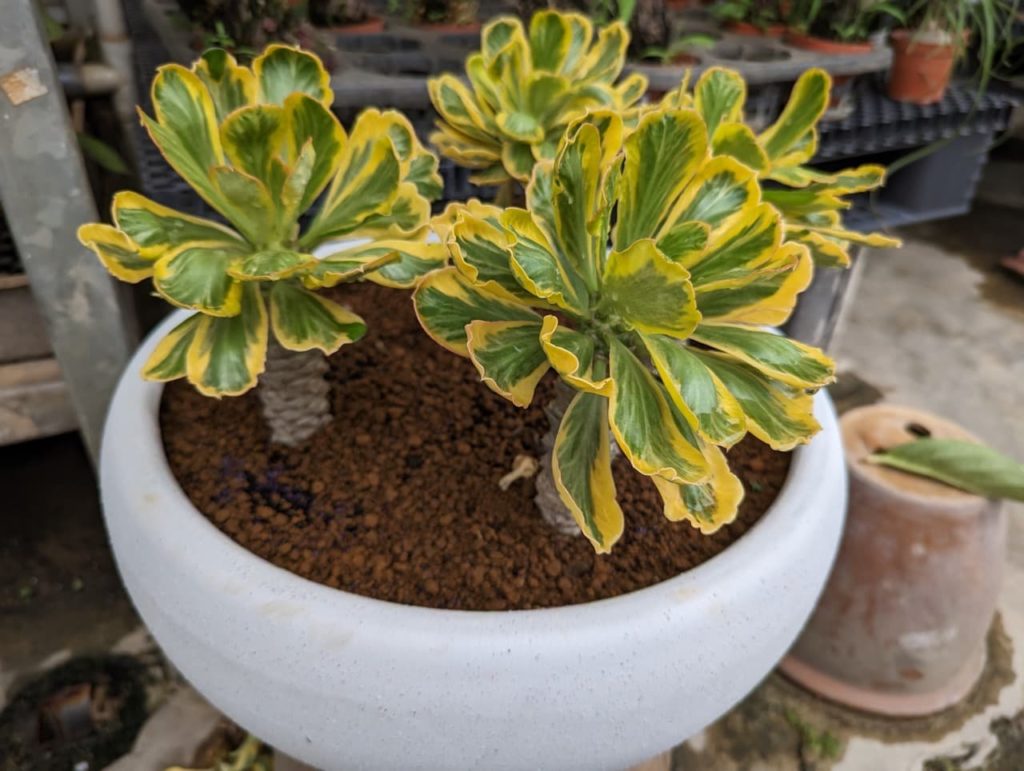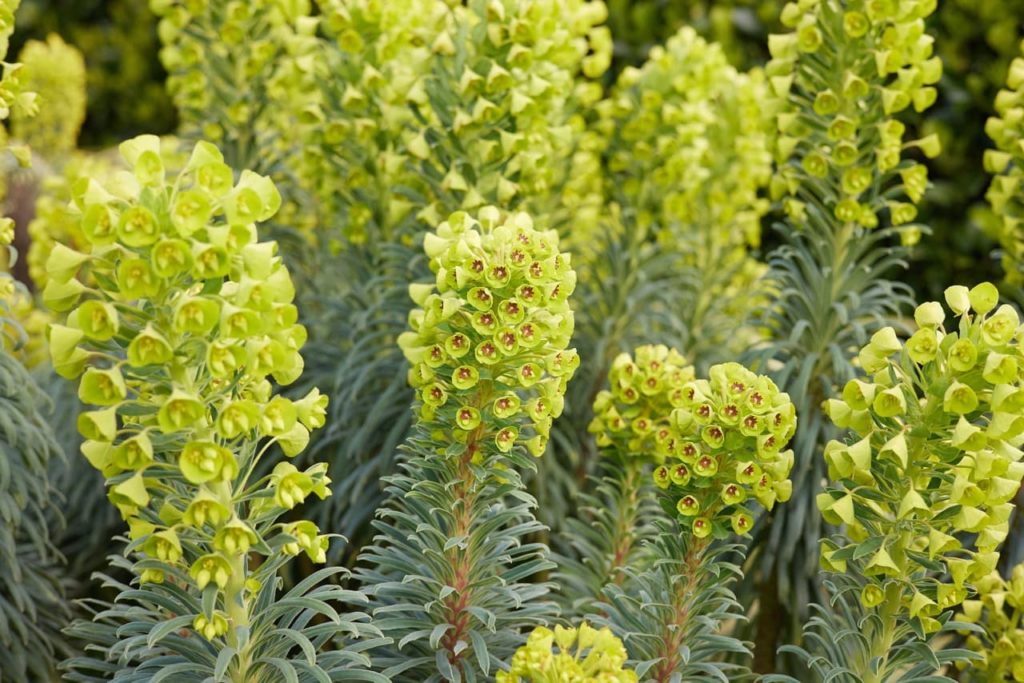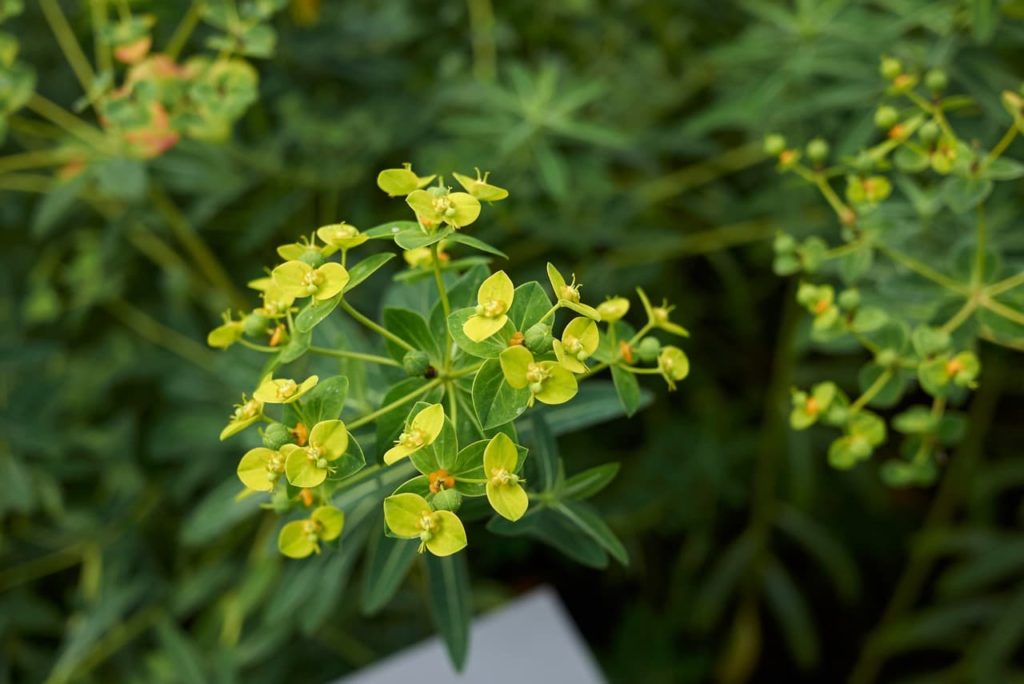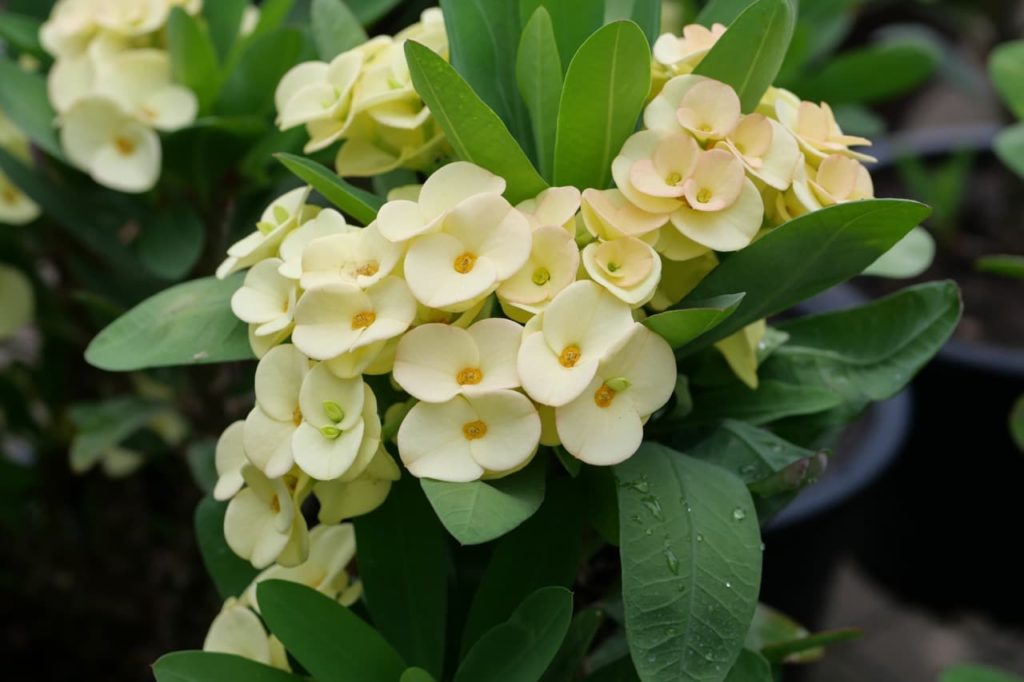PERENNIALS > EUPHORBIA

Elizabeth is a Permaculture Garden Designer, Sustainability Consultant and Professional Writer, working as an advocate for positive change. She graduated from the University of St. Andrews with an MA in English and Philosophy and obtained a Diploma in Applied Permaculture Design from the Permaculture Association.
Reviewed By COLIN SKELLY

Colin is a Horticulturist and Horticultural Consultant with experience in a range of practical and managerial roles across heritage, commercial and public horticulture. He holds the Royal Horticultural Society’s Master of Horticulture award and has a particular interest in horticultural ecology and naturalistic planting for habitat and climate resilience.
Contributions From DARREN EVANS

Darren is the Plant Manager at Pugh's Cacti, a wholesale supplier of cactus and succulent plants to garden centres in the UK, based in Worcestershire.
EUPHORBIA GUIDES
Euphorbia is a genus of plants that can offer a lot to gardeners.
Hugely diverse, this genus provides plants of a range of shapes and sizes for a wide range of locations, indoors and outside in a garden.
Across our Euphorbia guides, we’ve collaborated with Darren Evans, Plant Manager at Pugh’s Cacti.
“I love Euphorbias as they can be weird and wonderful,” he says.
“Some are classed as succulents but have spines that resemble a cactus, so it’s the best of both worlds.”
Overview
| Botanical Name | Euphorbia |
| Common Name(s) | Spurge |
| Plant Type | Annual / Perennial / Shrub / Succulent |
| Native Area | Broad range |
| Hardiness Rating | Varies considerably |
| Foliage | Diverse range |
| Flowers | Small flowers often in colourful bracts |
| When To Plant | Varies |
Sunlight
Preferred
Varies
Exposure
Varies
Size
Height
Varies
Spread
Varies
Bloom Time
Summer or Autumn
Soil
Preferred
Varies
Moisture
Varies
pH
Any
Euphorbias can be useful and attractive plants.
One of the most important things to understand about Euphorbias, or ‘spurges’ as they are sometimes known, is that they differ greatly in their characteristics and growing requirements, so it is important to choose carefully.
There are Euphorbias that are annuals, perennials, shrubs, succulents and even some that love moist conditions.

“With succulent euphorbias, you give them attention at certain times of the year and after that, you can just leave them to do their thing and flourish,” shares Darren.
“They can be easy to grow with a simple compost mix, plenty of light and regular watering when required.
“In return, they will reward you with beautiful flowers, elegant spines and wonderful shapes.”
There is a euphorbia for full sun and for shade, for use as a houseplant and as much hardier plants for year-round outdoor cultivation.
How To Grow Euphorbia
Selecting the right Euphorbia for the conditions where you want it to grow is the first and most important step in growing them successfully where you live.
Hardiness
When it comes to hardiness, plants within this genus range from tender to fully hardy, even in the UK during the coldest winters.
It can be helpful then to separate Euphorbias into garden Euphorbias (those hardy enough to grow outside) and indoor or greenhouse Euphorbias, which are not hardy enough to remain outside through the year and must be cultivated as houseplants or undercover.
Tender houseplant Euphorbias can be small balls or large branched shrubs.

These typically grow well in sun-baked conservatories throughout the year, though they can often be placed outside during the peak of summer.
Popular poinsettias are a member of this group and are commonly grown around Christmas.
Other examples are E. milii, E. milii var. splendens, E. horrida, and E. obesa.
Typically succulent in form and resembling cacti, these bear little resemblance to Euphorbias commonly grown outside in a garden.
Preferred Aspect
Garden euphorbias are all hardy enough to be grown outdoors in UK gardens.
However, even these plants differ greatly from one another.
These Euphorbias can be subdivided again into those that like to be grown in full sun and those that love shade.

Sun-loving spurges are mostly either herbaceous perennials that die back in winter and send up new growth each spring or have a permanent shrubby framework of branches.
There are also some annual Euphorbias for full sun that complete their lifecycles in a single year.
Some examples of sun-loving spurges include E. characias, E. griffithii, E. mellifera, E. palustris and E. rigida.
“My favourite Euphorbia is E. mellifera, also known as honey spurge,” says Master Horticulturist Colin Skelly.
“It will grow to around 2m tall and wide when thriving and can be grown in full sun or partial shade and in a range of soil types as long as free draining.
“It is loved by pollinators and has a pleasant fragrance. It can be pruned back in spring if needed. It is frost-hardy in all but the coldest parts of the UK.”
Most of these really do best with excellent drainage and won’t tolerate waterlogging at all, but E. griffithii and E. palustris are content in damp soil.

Annuals include E. lathyris, E. marginata, and E. oblongata.
E griffithii can also cope well with dappled shade and E. amygdaloides and E. amygdaloides var. robbiae are also Euphorbias that are tolerant of dappled shade.
These Euphorbias will not like soil that dries out too excessively and in some cases in full sun, the flowers and leaves of these plants can scorch.
Sun-loving Euphorbias will tend to do best with a south-facing aspect, while those that thrive in partial or dappled shade do well with an east or west-facing aspect.
Preferred Soil & Drainage
Garden Euphorbias differ not only in their sunlight requirements but also in their preferred soil type and soil conditions.
Some Euphorbias, such as E. cornigera and E. schillingii, will grow well in most soil types as long as they do not become waterlogged.

Euphorbia such as E. characias subsp. wulfenii and E. rigida do best in sandy soils that are free-draining.
Among those that grow well in part shade, E. amygdaloides var. robbiae is a good choice for dry shade, while E. palustris is an example of one Euphorbia that can work in damp soils.
It is, of course, important to make sure that you understand the needs of the particular Euphorbia that you are trying to grow before selecting and preparing a planting site.
Euphorbia Planting
Euphorbias are commonly sold as potted plants, either as smaller plants in spring or larger plants that are often in flower in summer or early autumn.
Mostly, these plants come in 1 or 2-litre pots, though sometimes plants in 9cm wide pots are available.
Garden Euphorbias are best planted out in a garden in the spring, once the weather begins to warm.
This is the best time for planting because it allows the plants to establish quickly while the soil is relatively moist and put on plenty of growth during warmer weather.

To plant a Euphorbia in the soil, simply dig a hole larger than the existing roots of the plant, place the plant in this hole, firm the soil back around it and water it in well.
In many cases, the addition of organic mulch around the plant can be beneficial.
Some Euphorbias are suited to container growing.
These can thrive in the free-draining conditions that a suitable container can provide.
Mix a potting medium with three-parts loam-based compost to one-part grit to keep these plants happy.
Euphorbia Plant Care
Euphorbias require very different care depending on the specific types and varieties you have chosen and where they are growing.

Some take a lot more time and effort, while others can be relatively low-maintenance and easy plants to grow.
Watering
Garden Euphorbias typically need to be watered well during establishment for their first couple of growing seasons, after which natural rainfall will typically be sufficient, as the plants can often have reasonable drought tolerance.
However, if you are growing euphorbias in containers, indoors or outside, watering will be a job that you will have to continue to undertake throughout the year from spring to autumn.
The goal is typically to make sure that the growing medium remains moist yet not waterlogged and never dries out completely during the growing season.
Feeding
Euphorbias tolerate poor fertility rather well and they do not typically need to be fed at all.

In fact, feeding can be counterproductive because plants that are in too rich a soil or growing medium can become leggy.
Common Problems
Euphorbias are often blissfully trouble-free plants.
However, they can develop a number of minor issues, especially if environmental conditions or care were not quite right.
Common problems include root rot (when grown in wet soils), powdery mildews, rust diseases and aphids.
FAQs
What Are Some Good Companion Plants?
Which plants make good companions for Euphorbias very much depends on which euphorbias you have chosen to grow and where you are growing them.

Remember, good companions, are first and foremost those that require the same growing conditions and will not compete with your euphorbia.
Sun-loving Euphorbias can often look wonderful and do well in a prairie-style planting scheme alongside salvias, alliums and verbascums, to name just one example of a possible polyculture planting scheme.
Can Euphorbias Grow In Shade?
As mentioned above, there are many euphorbias that will not do well in shade and which require a position in full sun.

However, there are also euphorbias that grow well in partial or dappled (though not deep) shade, such as E. griffithii and E. amygdaloides.
Should You Deadhead Euphorbia?
Deadheading may be beneficial for Euphorbias which have a permanent framework of branches and you may also decide to shear off the flower stalks of ground cover Euphorbias to tidy things up.
Having said that, in many cases, deadheading Euphorbias will not be essential at all.
How Tall Will It Typically Grow?
Euphorbias vary greatly in the size to which they will grow.

There are spurges that grow only around 10cm tall which are suited to growing at the front of a border and those that can grow to more than 2m which would be suited to the back of a bed or border.

